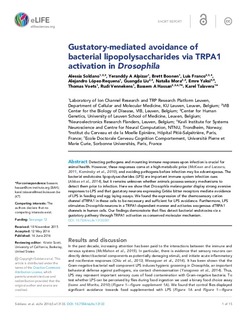| dc.contributor.author | Soldano, Alessia | |
| dc.contributor.author | Alpizar, Yeranddy A | |
| dc.contributor.author | Boonen, Brett | |
| dc.contributor.author | Franco, Luis | |
| dc.contributor.author | Lopez-Requena, Alejandro | |
| dc.contributor.author | Liu, Guangda | |
| dc.contributor.author | Mora, Natalia | |
| dc.contributor.author | Yaksi, Emre | |
| dc.contributor.author | Voets, Thomas | |
| dc.contributor.author | Vennekens, Rudi | |
| dc.contributor.author | Hassan, Bassem A | |
| dc.contributor.author | Talavera, Karel | |
| dc.date.accessioned | 2018-03-02T13:54:15Z | |
| dc.date.available | 2018-03-02T13:54:15Z | |
| dc.date.created | 2016-12-07T12:18:29Z | |
| dc.date.issued | 2016 | |
| dc.identifier.citation | eLIFE. 2016, 5:e13133. | nb_NO |
| dc.identifier.issn | 2050-084X | |
| dc.identifier.uri | http://hdl.handle.net/11250/2488378 | |
| dc.description.abstract | Detecting pathogens and mounting immune responses upon infection is crucial for animal health. However, these responses come at a high metabolic price (McKean and Lazzaro, 2011, Kominsky et al., 2010), and avoiding pathogens before infection may be advantageous. The bacterial endotoxins lipopolysaccharides (LPS) are important immune system infection cues (Abbas et al., 2014), but it remains unknown whether animals possess sensory mechanisms to detect them prior to infection. Here we show that Drosophila melanogaster display strong aversive responses to LPS and that gustatory neurons expressing Gr66a bitter receptors mediate avoidance of LPS in feeding and egg laying assays. We found the expression of the chemosensory cation channel dTRPA1 in these cells to be necessary and sufficient for LPS avoidance. Furthermore, LPS stimulates Drosophila neurons in a TRPA1-dependent manner and activates exogenous dTRPA1 channels in human cells. Our findings demonstrate that flies detect bacterial endotoxins via a gustatory pathway through TRPA1 activation as conserved molecular mechanism. | nb_NO |
| dc.language.iso | eng | nb_NO |
| dc.publisher | eLife Sciences Publications | nb_NO |
| dc.rights | Navngivelse 4.0 Internasjonal | * |
| dc.rights.uri | http://creativecommons.org/licenses/by/4.0/deed.no | * |
| dc.title | Gustatory-mediated avoidance of bacterial lipopolysaccharides via TRPA1 activation in Drosophila | nb_NO |
| dc.type | Journal article | nb_NO |
| dc.type | Peer reviewed | nb_NO |
| dc.description.version | publishedVersion | nb_NO |
| dc.source.volume | 5 | nb_NO |
| dc.source.journal | eLIFE | nb_NO |
| dc.source.issue | 2016 | nb_NO |
| dc.identifier.doi | 10.7554/eLife.13133 | |
| dc.identifier.cristin | 1409452 | |
| dc.relation.project | EU/Grant reference number- IUAP P7/13 | nb_NO |
| dc.description.localcode | © Soldano et al. This article is distributed under the terms of the Creative Commons Attribution License, which permits unrestricted use and redistribution provided that the original author and source are credited. | nb_NO |
| cristin.unitcode | 194,65,60,0 | |
| cristin.unitname | Kavliinstitutt for nevrovitenskap | |
| cristin.ispublished | true | |
| cristin.fulltext | original | |
| cristin.qualitycode | 1 | |

